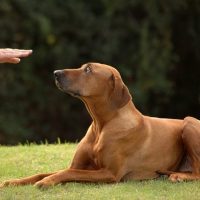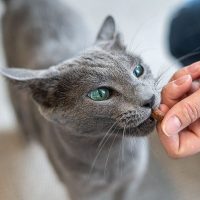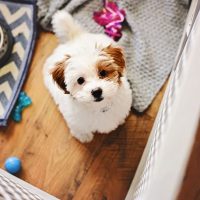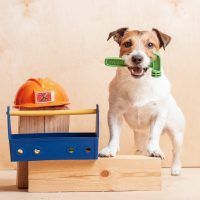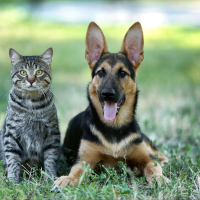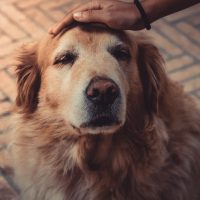At what age can I start training my new puppy?
Your new puppy is learning during every waking moment! Every interaction you have with your puppy from the first time you meet will be a form of training. Housetraining, household manners, and social experiences are all forms of training you’ll be doing with your puppy from the first time they come home. In some situations, puppies will even begin some amount of formal training before they go to their new home, such as a start on housetraining, greetings, and how their actions can lead to rewards.
How do puppies learn?
Puppies, like all animals, learn by doing what works for them. They will do what is effective, from their point of view. Puppies will repeat behaviors that have a good result. If it leads to a treat, attention, a toy, a desired interaction, or the ability to explore, sniff, or run, the puppy will do it again in the future. In general, teaching puppies what to do through praise and rewards (positive reinforcement) is the best practice. Setting puppies up for success using management, supervision, and positive reinforcement training plans is effective and safe. Waiting until the puppy does something you don’t want and then trying to punish the behavior can lead to problems such as avoidance, fear, and confusion.
“In general, teaching puppies what to do through praise and rewards (positive reinforcement) is the best practice.”
First, learn what your puppy likes then make sure she receives something she likes any time she does something you like! It’s a simple concept, but it can be tricky to implement. Remember, a reward or reinforcement should always be from the puppy’s point-of-view.
Example: What if my puppy likes attention and petting? My puppy jumps up on me and I bend to put my hands on him, pushing him off my legs while saying “off.” He jumps again, and we repeat the process.
Think about this from the puppy’s perspective: I am ignoring the puppy > puppy jumps up > I touch the puppy and talk to him. Guess what, it worked! Puppies do not act out to upset us or compete with us. They just do what works, from their point of view.
What should I teach my puppy?
In general, the best approach is to consider what you want your puppy to do; what is the desired course of action in a situation or in response to a cue? Some examples include:
• When the puppy sees a person
• When the puppy hears her name
• When the puppy sees another animal
• When the puppy hears the doorbell
• Where the puppy should rest or sleep
• How to get his leash and/or harness on
• How to respond to grooming, brushing, and veterinary care
Once you have a clear picture of how you wish your puppy to behave, then you can begin teaching him baby steps toward the goal. For example, when your puppy hears his name, you want him to come to the person who called him and wait near that person. This response can be trained using a combination of luring, capturing, and shaping. We will follow this example throughout.
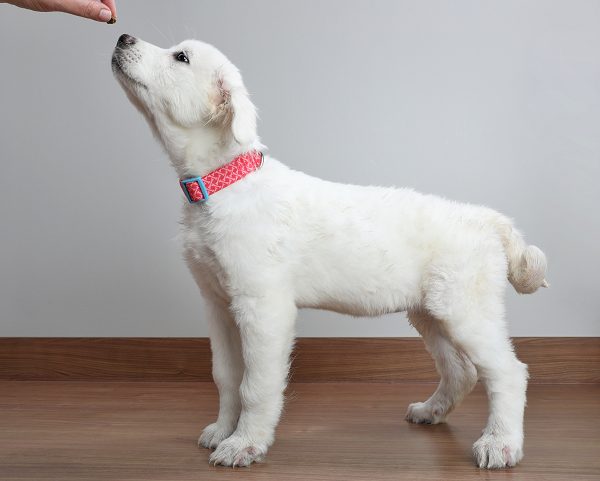
What is luring and how do I use it?
Lure training is the use of a treat or something else the puppy will predictably follow to show the puppy what to do. Luring is useful for teaching new behaviors the first few times they are introduced. The lure is usually faded away quickly once the puppy starts to show understanding.
The lure should be like a magnet, where the puppy’s nose is attracted and attached. Moving the lure will move the puppy’s nose into the right position, and where the nose goes, the body will follow. Treats are the easiest lure. Use tiny treats the size of a pencil eraser that are high in value.
“Moving the lure will move the puppy’s nose into the right position, and where the nose goes, the body will follow.”
Example: My puppy is sniffing the ground nearby. I call his name and, without delay, I place a delicious treat right under his nose. When his nose is magnetized to the treat, I draw a slow steady line with the treat toward my body, and back up a few steps, giving the puppy tiny licks or bites of the treat throughout.
For a puppy to sit, the lure should be slowly raised up and back. When a puppy’s nose goes up and back, his rump will usually go down into a sit.
For a puppy to walk to his bed or into a kennel, the lure should be at nose level where the puppy can easily follow it, and they should receive a lick or bite every few steps until they reach the goal location where another treat is delivered.
What if my puppy doesn’t follow the lure?
If the lure is moving too fast or is out of reach, the puppy may lose interest, or even become frustrated and try to claw at, jump at, or bite the lure. Make sure the lure moves at a speed that is easy to follow, the puppy is able to reach the lure at all times without jumping or grabbing, and little licks or bites are given regularly throughout the exercise to maintain interest and attachment.
What is capturing?
Capturing means the puppy is naturally doing the behavior in question, and the trainer will “mark” the behavior when it happens and deliver a reward such as a treat or a toy. Capturing is useful because it teaches humans to observe the puppy’s behavior regularly, and to constantly be on the lookout for right choices. Puppies make a lot of right choices every day, though the choices may be brief at first! Watch for right choices, mark them, and reward after the marker.
What is a marker?
A marker is a signal to the puppy that something they love is coming right away! For example, a delicious treat or a favorite toy. A marker is an IOU for something the puppy loves. The marker needs to be brief, just a fraction of a second. A marker is different from general, ongoing praise or attention. A marker can be any sound, gesture, or touch. Sounds and gestures are easiest to train and touch can be used for puppies who may have limited vision or hearing. Some common markers include:
• Clicker
• Short word (Yes, Nice, Click, Good, Beep, etc.)
• Sound or whistle
• Thumbs up gesture
• Light touch on the shoulder
“A marker is an IOU for something the puppy loves.”
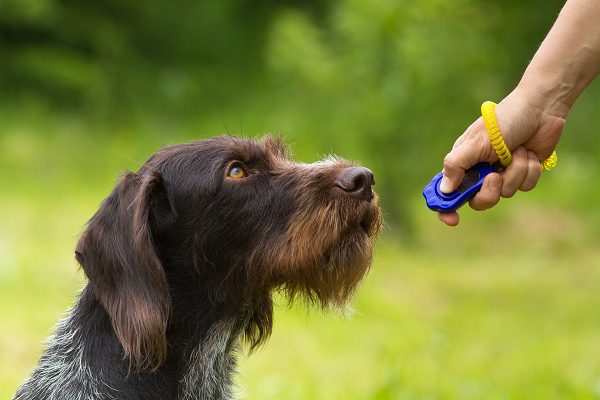
Markers can be used in both capturing and shaping (explained next) to tell the puppy when he has made a choice that will lead to a treat. An example of capturing your puppy responding to his name is to wait for times when he chooses to look at you and move toward you – without calling him. When he moves toward you, call his name, mark (click, “Yes,” etc.) during the movement, then give a treat when he arrives.
What is shaping?
Shaping is teaching the desired behavior through trial and error, by rewarding any correct guess that resembles the goal. As the learner gets a better idea of what the goal might be, the trainer increases the criterion of how close the guess must be to the goal to receive a marker and reward. Shaping can be frustrating for both trainers and puppies in the beginning, but once both the human and the dog understand the process, it is an exceptionally powerful tool for teaching complex skills and a great deal of fun for everyone involved.
For an example of shaping your puppy’s response to his name, you could initially mark any of the following responses when he hears it:
• Stops or pauses whatever he is doing, without looking at you
• Raises the nose 1” off the ground if he was sniffing
• Moves the nose 1” in your direction, on or off the ground
As the puppy becomes more proficient, you can increase the criteria:
• Gradual increases in how far off the ground the nose comes, or how much toward you the nose moves
• Gradually add the head turning all the way toward you and looking at you
• Gradually add movement toward you after the head turn
One interesting effect of training name recognition with shaping is that, typically, once the puppy understands the marker he will usually come running to you for a treat to collect on that IOU! This is convenient because it also happens to complete the behavior of coming when called.
What if my puppy doesn’t respond to the marker?
Most often, this happens when the environment in which you are trying to train is too exciting or stimulating. Start training in easy places like inside the home with few distractions. As the puppy learns each skill, begin practicing that skill in new locations like other rooms of the house, the yard, or on a walk when there are no dogs or strangers nearby, and then eventually when you’re in the presence of strangers. Practicing in a positive reinforcement puppy class or puppy kindergarten is a great way to help puppies learn how to work together with their families even when there are distractions present.
If your puppy normally responds to the marker by looking for a treat and has suddenly stopped, check to make sure your treats are a good value, that your puppy is feeling well, and that he is still at least a little hungry.
When and how should I use a cue?
A cue is a word, gesture, or situation that tells the puppy a reward is available if she does something specific. For example, saying “sit” means the puppy will receive a treat or other reward if she assumes a sitting position. To start matching cues with actions, say the cue (or show the gesture) when you’re certain you can show the puppy how to successfully earn a reward. For example, saying “Puppy, come!” in an environment with few distractions and while your puppy is wearing a leash, then luring the puppy to you.
For captured behaviors, say the cue right when you believe the puppy is likely to do the behavior.
For shaping, add the cue when you’re confident the puppy knows how to perform the behavior.
Remember, the cue is a signal that reinforcement is available. A reward may be a mark and a treat, excited verbal praise, petting, or playing with a toy. The reward can be anything the puppy finds pleasurable, but the cue means the reward will follow the behavior. Always reward when your puppy responds to the cue.
“The reward can be anything the puppy finds pleasurable, but the cue means the reward will follow the behavior.”
As your puppy becomes more experienced, the cue will be a signal that a reward is available but only for a limited time. This will speed up the puppy’s responses to cues. Adding the criteria of speed is an advanced technique and should be added when the puppy is more experienced and mature.
What if my puppy doesn’t obey?
Cues are not commands, and the expectation for a dog to “obey” is somewhat outdated. If your puppy doesn’t follow a cue, consider these possible causes:
• The puppy is distracted
• The puppy is confused
• The puppy does not understand how to respond to the cue in the current location or environment
• The puppy does not understand how to respond to the cue on this surface
• There is a competing motivation (something else has the puppy’s attention)
• The puppy is too tired or is over-excited
Any of these causes can be remedied by meeting the needs of the puppy at that moment to help him be successful, or simply by pausing the training session and trying again later. Young puppies need plenty of guidance and grace from their people, as well as consistency, so they can trust and learn as they mature.
How do I fade out the lure?
When we are luring, we use treats in our hands like a magnet to guide the puppy to the goal. With most puppies, you can switch to using an empty hand in the same shape and gesture to show the path to the goal within 5-10 repetitions. If the puppy loses interest, alternate between an empty hand and a hand with treats in it. Gradually decrease the number of repetitions where the hand has treats until it never does. Always continue to reward when the puppy achieves the goal. This is how to move from lure training to reward-based training.
When can I stop giving treats?
Plan to continue paying your dog a paycheck in exchange for work throughout her entire life. As she matures, she will be able to perform more behaviors for a single treat or reward and work for longer and longer periods of time. Plan to use treats during every training session throughout puppyhood.
How much time should I spend training my puppy every day?
Training happens all the time. Whenever you’re with your puppy while she’s awake, you’re guiding her choices by how you respond and how you provide rewards. Individual training sessions for cues or skills should be no more than a few minutes long at first and can be done a few times a day. Teach quiet skills like going to the crate, going to bed, or lying down when your puppy is feeling calmer. Teach exciting skills such as to come when called or to retrieve a toy when your puppy is more energetic.
What can be done if my puppy is too distracted or excitable to control?
Training should begin in a quiet environment with few distractions. The chosen reward should be highly motivating so that the puppy focuses entirely on the trainer and the reward. Although a small food treat generally works best, a favorite toy or a special dog treat might be more appealing for some puppies. It might also be helpful to train the puppy just before a scheduled mealtime when he is at his hungriest.
If you feel frustrated or like the puppy is highly excitable or difficult, reach out for professional guidance. A skilled positive reinforcement trainer will help you enjoy your puppy so much more as time goes on.
“If you feel frustrated or like the puppy is highly excitable or difficult, reach out for professional guidance.”
When should I start socializing my puppy?
Socialization should begin as soon as you get your puppy and, often, this is at seven or eight weeks of age. Puppies naturally accept new people, other animals, and new situations during the socialization period, which occurs between 7 and 14 weeks of age. This period provides an opportunity for a myriad of introductions that will provide positive memories that last a lifetime. Puppies are eager, exploratory, and uninhibited during this period, and it is important to take advantage of this enthusiasm. Be sure to protect your puppy during this period and ensure that all experiences are positive, fun, and safe.
Why does my 16-week-old puppy seem afraid?
There is a normal, natural fear period that begins around 14 to 16 weeks of age. During this period, a puppy may become wary and suspicious of new people, animals, or experiences. This is a normal adaptive process. Watch your puppy closely for signs of fear (cowering, urinating, and refusal of food or treats). Avoid pushing or overwhelming your puppy during this developmental stage. Always let your puppy guide the pace of experiences, especially during sensitive periods.
Should I also consider training classes?
Yes! A good positive reinforcement-based group class is an excellent way to introduce yourself and your puppy to training. Even experienced trainers often enroll their own puppies in group classes to take advantage of this wonderful, varied, controlled, and safe environment to learn and practice new skills. In addition, you will learn how to prevent problems before they can begin, or deal with them as they emerge, rather than having to find a way to react to problems after they have already developed.
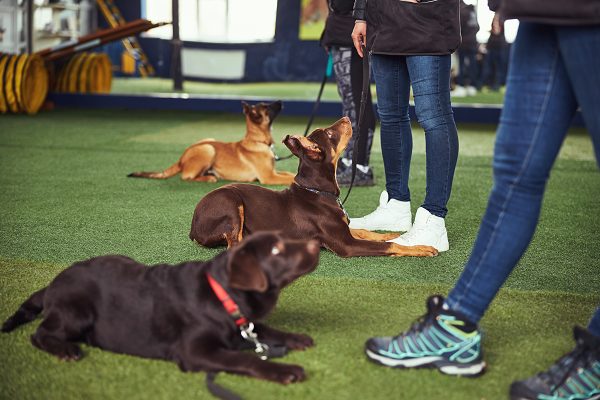
Training classes for young puppies are also an excellent way to socialize your new puppy to a variety of people, dogs, and other stimuli in a controlled environment. Your puppy might also make some new friends of the same age. You could then visit these friends (or vice versa) with your puppy for social play and exercise sessions. Puppy socialization classes are most valuable for puppies eight weeks of age and older. If all puppies in the class have had initial vaccinations, are healthy, and are parasite free, the health risks are low, and the potential benefits are enormous.
Discuss the puppy training options in your area and the ideal time for enrolment with your veterinarian.
© Copyright 2022 LifeLearn Inc. Used and/or modified with permission under license.
